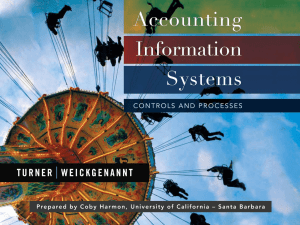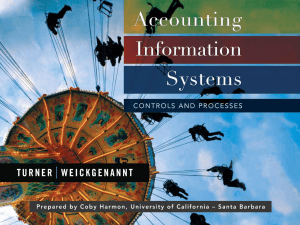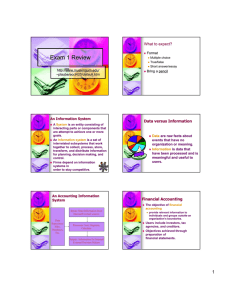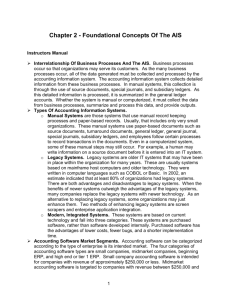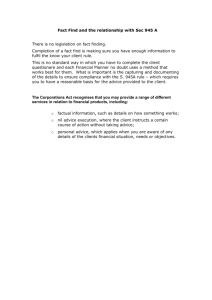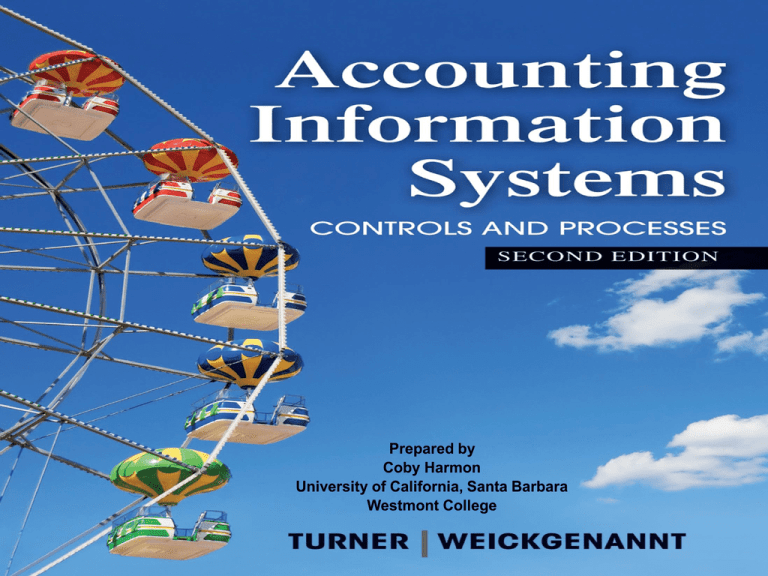
Prepared by
Coby Harmon
University of California, Santa Barbara
Westmont College
Chapter
2-1
Foundational
Concepts of the AIS
Chapter
2-2
Accounting Information Systems, 2nd Edition
Study Objectives
1.
The interrelationships of business processes and the AIS
2.
Types of accounting information systems
3.
Client-server computing
4.
Cloud computing
5.
Accounting software market segments
6.
Input methods used in business processes
7.
The processing of accounting data
8.
Outputs from the AIS related to business processes
9.
Documenting processes and systems
10. Ethical considerations at the foundation of accounting information
systems
Chapter
2-3
Business Processes and the AIS
Accounting Information System - a system that
captures, records, processes, and reports accounting
information.
Business Process - a prescribed sequence of work steps
completed in order to produce a desired result.
Chapter
2-4
SO 1 The interrelationships of business processes and the AIS
Business
Processes
and the AIS
Exhibit 2-1
Overall View of Transactions,
Processes, and Resulting Reports
Chapter
2-5
SO 1 The interrelationships of business
processes and the AIS
Business Processes and the AIS
Question
1. Which of the following statements is not true?
a. Accounting information systems must maintain both detail
and summary information.
b. Business processes may vary from company to company.
c. Regardless of the extent of computerization, all accounting
information systems must capture data from the transactions
within business processes.
d. Business processes categorized as expenditure processes
are not intended to be processes that serve customers.
Chapter
2-6
SO 1 The interrelationships of business processes and the AIS
Types of Accounting Information Systems
Three categories of AIS:
1. Manual systems
2. Legacy systems
3. Modern, integrated IT systems
Chapter
2-7
SO 2 Types of accounting information systems
Types of Accounting Information Systems
Manual Systems
Generally used by small organizations. Entirely manual
system would require:
Chapter
2-8
Source document
General journal
Turnaround document
Special journals
General ledger
Subsidiary ledgers
SO 2 Types of accounting information systems
Types of Accounting Information Systems
Legacy Systems
Existing system, often based on old technology.
Advantages are that legacy systems:
1. Customized to specific needs.
2. Support unique business processes not inherent in generic
accounting software.
3. Contain invaluable historical data that may be difficult to
integrate into a new system.
4. Well supported and understood by existing personnel.
Chapter
2-9
SO 2 Types of accounting information systems
Types of Accounting Information Systems
Legacy Systems
Disadvantages are that legacy systems:
1. Costly to maintain.
2. Often lack adequate supporting documentation.
3. Hardware needed to maintain may become obsolete.
4. Not usually based on user-friendly interfaces.
5. Tends to use software written in older computer languages.
6. Often difficult to modify to make user friendly.
7. Difficult to integrate when companies merge.
Chapter
2-10
SO 2 Types of accounting information systems
Types of Accounting Information Systems
Legacy Systems
Decision whether to replace or update legacy systems.
1. Screen scrapers
2. Enterprise application integration
3. Complete replacement of legacy systems
Chapter
2-11
SO 2 Types of accounting information systems
Types of Accounting Information Systems
Modern, Integrated Systems
New programs sold by software development companies are
more user friendly than legacy accounting systems.
Advantages to purchasing accounting software:
1. Lower cost
2. Shorter implementation time
3. Fewer bugs
Chapter
2-12
SO 2 Types of accounting information systems
Types of Accounting Information Systems
Question
In a manual system, an adjusting entry would most likely be
initially recorded in a
a. special journal.
b. subsidiary ledger.
c. general journal.
d. general ledger.
Chapter
2-13
SO 2 Types of accounting information systems
Types of Accounting Information Systems
Question
Which of the following is not a disadvantage of maintaining legacy
systems?
a. There are fewer programmers available to support and
maintain legacy systems.
b. They contain invaluable historical data that may be difficult
to integrate into newer systems.
c. Hardware or hardware parts may be unavailable for legacy
systems.
d. It can be difficult to integrate various legacy systems into an
integrated whole.
Chapter
2-14
SO 2 Types of accounting information systems
Types of Accounting Information Systems
Question
Which of the following is a disadvantage of purchased
accounting software, compared with software developed inhouse?
a. It is custom designed for that company.
b. It is less costly.
c. The implementation time is shorter.
d. There are fewer bugs.
Chapter
2-15
SO 2 Types of accounting information systems
Client–Server Computing
Two types of computers are networked together to
accomplish the application processing.
Characteristics:
1. Client and server computer are networked together.
2. System appears to users to be one integrated whole.
3. Individual parts of processing are shared between server and
client.
4. Client computer participates in processing or data
manipulation in some meaningful way.
Chapter
2-16
SO 3 Client-server computing
Client–Server Computing
Two Levels of Client-Server Computing:
1. Distributed presentation.
2. Distributed applications.
Chapter
2-17
SO 3 Client-server computing
Cloud Computing
Recently, there has been a movement away from a client-
server approach toward cloud computing. It includes:
► Software and data reside with third party companies (the cloud)
and not on company computers.
► Outsourcing of IT to a third party.
Advantages:
Chapter
2-18
1. Scalability
3.
Infrastructure is reduced
2. Expanded access
4.
Cost savings
SO 4 Cloud computing
Cloud
Computing
Exhibit 2–2
Cloud Hosting of Accounting
Software
Chapter
2-19
SO 4 Cloud computing
The Real World
Thomas Kemper Soda Company of Portland, Oregon, is a small-batch craft-brewer
of root beer, ginger ale, and other natural soft drinks sold in the western United
States. After years of struggling with communication and information sharing
between the members of its mobile workforce, the company recently began
subscribing to cloud based Microsoft Office 365. Significant improvements were
realized very quickly. Rather than depending upon e-mail for sharing information
and documentation, management at Thomas Kemper began accessing its file-share
server through the cloud. They saved time; obtained better, more secure and up-todate information; and were therefore able to work together more effectively. Cloudbased conferencing, e-mailing, calendaring, and screen-sharing all make it possible
for the employees to stay connected despite their various physical locations. In
addition, the company’s management team estimates that 40 hours of employee
productivity are gained each week due to communication efficiencies, six hours are
saved each week on technology support, and thousands of dollars of expenses
have been avoided, including over $10,000 of hardware upgrade costs.
Chapter
2-20
SO 4 Cloud computing
Accounting
Software
Market
Segments
Exhibit 2-2
Accounting Software Market
Segments and Movement in
the Market
Chapter
2-21
SO 5 Accounting software market segments
Accounting Software Market Segments
Exhibit 2-3
Popular Accounting Software Programs within
the Market Segments
Chapter
2-22
SO 5 Accounting software market segments
Accounting Software Market Segments
Question
Which of the following is not a method of updating legacy
systems?
a. Enterprise application integration.
b. Backoffice ware.
c. Screen scraper.
d. Complete replacement.
Chapter
2-23
SO 5 Accounting software market segments
Accounting Software Market Segments
Question
When categorizing the accounting software market, a
company with revenue of $8 million would most likely
purchase software from which segment?
a. Small company.
b. Midmarket.
c. Beginning ERP.
d. Tier 1 ERP.
Chapter
2-24
SO 5 Accounting software market segments
Input Methods Use In Business Processes
Input methods used in organizations:
► Source Documents and Keying
► Bar Codes
► Point of Sale Systems
► Electronic Data Interchange (EDI)
► E-Business and E-Commerce
Chapter
2-25
SO 6 Input methods used in business processes
Input Methods Use In Business Processes
Question
An IT system that uses touch-screen cash registers as an
input method is called
a. Electronic data interchange.
b. E-business.
c. Point of sale system.
d. Source documents and keying.
Chapter
2-26
SO 6 Input methods used in business processes
Processing Methods
Batch Processing - Transactions are grouped.
Advantages
1. Efficient for large volumes of like transactions.
2. Audit trail is maintained.
3. Generally use less costly hardware and software.
4. Hardware and software systems are not as complicated as online systems.
5. Generally easier to control than other types of computerized
systems.
6. Personnel become specialized and efficient in processing
routine transactions.
Chapter
2-27
SO 7 The processing of accounting data
Processing Accounting Data
Batch Processing - Transactions are grouped.
Disadvantages
1. Processing can take longer.
2. Adding or deleting records takes much computer maintenance
time.
3. Some data duplication is likely.
4. Integration across business processes is difficult in legacy
systems that are batch oriented.
5. Lag while all transactions in a batch are collected.
6. May require that transaction and master files be sorted in the
same sequential order.
Chapter
2-28
SO 7 The processing of accounting data
Processing Accounting Data
Online and Real-Time Processing
Advantages
1. System checks for input errors.
2. Information provided on a timely basis.
3. All files are constantly up to date.
4. The business processes are integrated into a single database
so that a single system is achieved.
Chapter
2-29
SO 7 The processing of accounting data
Processing Accounting Data
Online and Real-Time Processing
Disadvantages
1. Hardware and software are more expensive than a batch
systems.
2. A single database that is shared is more susceptible to
unauthorized access of data.
3. Real-time systems can be difficult to audit.
Chapter
2-30
SO 7 The processing of accounting data
Processing Accounting Data
Question
When similar transactions are grouped together for a
specified time for processing, it is called
a. Online processing.
b. Real-time processing.
c. Batch processing.
d. Group processing.
Chapter
2-31
SO 7 The processing of accounting data
Outputs of the AIS
General Categories of Outputs
1. Trading partner documents such as checks, invoices,
and statements
2. Internal documents
3. Internal reports
4. External reports
Chapter
2-32
SO 8 Outputs from the AIS related to business processes
Documenting Processes and Systems
Pictorial Representations of processes and systems
include:
1. Process maps
2. System flowcharts
3. Document flowcharts
4. Data flow diagrams
5. Entity relationship diagrams (ER diagrams)
Chapter
2-33
SO 9 Documenting processes and systems
Documenting Processes and Systems
Process Maps
Pictorial representations of business processes in which the
actual flow and sequence of events in the process are
presented in diagram form.
Exhibit 2-6
Process Map Symbols
Start or
Finish
Task or
Activity
Connector
Decision
Direction
of Flow
Chapter
2-34
SO 9 Documenting processes and systems
Documenting Systems
Exhibit 2-8
Common System Flowchart Symbols
System
Flowcharts
Intended to depict
the entire system,
including inputs,
manual and
computerized
processes, and
outputs.
Chapter
2-35
SO 9 Documenting processes and systems
Documenting Systems
Document
Flowcharts
Flow of
documents and
information among
departments or
units within an
organization.
Chapter
2-36
Exhibit 2-9
Payroll System
Flowchart
Documenting Systems
Chapter
2-37
Exhibit 2-10
Restaurant Process Map
Exhibit 2-11
Restaurant Document Flowchart
Chapter
2-38
Exhibit 2-11
Restaurant Document Flowchart
Chapter
2-39
Documenting Systems
Exhibit 2-12
Restaurant Data Flow Diagram
Data Flow Diagrams
Used to show the logical
design of a system.
Chapter
2-40
Documenting Processes and Systems
Entity Relationship Diagrams
Pictorial representations of the logical structure of
databases.
Chapter
2-41
►
Entities - items in the accounting system, such as
employees, customers, vendors, and inventory items.
►
Each entity has attributes, such as last name, first
name, pay rate, and number of withholdings.
SO 9 Documenting processes and systems
Documenting Processes and Systems
Entity Relationship Diagrams
Cardinality refers to how many instances of an entity
relate to each instance of another entity.
Chapter
2-42
1.
One to one: Each employee has one personnel file.
2.
One to many: One supervisor has many employees.
3.
Many to many: Each vendor can sell many items.
SO 9 Documenting processes and systems
Documenting Systems
Exhibit 2-15
ERD of Internet Sales
Entity
Relationship
Entity
Relationship Diagrams
Diagrams
Chapter
2-43
SO 9 Documenting processes and systems
Documenting Processes and Systems
Question
In documenting systems, which pictorial method is described
as a method that diagrams the actual flow and sequence of
events?
a. System flowchart.
b. Process map.
c. Data flow diagram.
d. Entity relationship diagram.
Chapter
2-44
SO 9 Documenting processes and systems
Ethical Considerations of AIS
► Accountants should be aware of opportunities for
unethical behaviors within the various business
processes.
► As a company chooses features and options for its
accounting information systems, the importance of
monitoring those systems should not be overlooked as a
factor in decision making.
Chapter
2-45
SO 10 Ethical considerations at the foundation
of accounting information systems
APPENDIX: Resources Events Agents
The REA model
views accounting
data collection as a
system to collect
data about the
resources, events,
and agents within
business processes.
Exhibit 2-16
An REA Pattern for Sales
Chapter
2-46
Copyright
Copyright © 2013 John Wiley & Sons, Inc. All rights reserved.
Reproduction or translation of this work beyond that permitted in
Section 117 of the 1976 United States Copyright Act without the
express written permission of the copyright owner is unlawful.
Request for further information should be addressed to the
Permissions Department, John Wiley & Sons, Inc. The purchaser
may make back-up copies for his/her own use only and not for
distribution or resale. The Publisher assumes no responsibility for
errors, omissions, or damages, caused by the use of these
programs or from the use of the information contained herein.
Chapter
2-47

